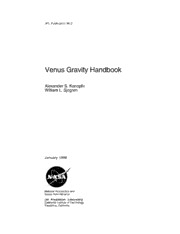
NASA Technical Reports Server (NTRS) 19970037571: Venus Gravity Handbook PDF
Preview NASA Technical Reports Server (NTRS) 19970037571: Venus Gravity Handbook
JPL Publication 96-2 Venus Gravity Handbook Alexander S. Konopliv William L. Sjogren January 1996 National Aeronautics and Space Administration Jet Propulsion Laboratory California Institute of Technology Pasadena, California The research described in this publication was carried out by the Jet Propulsion Laboratory, California Institute of Technology, under a contract with the National Aeronautics and Space Administration. Reference herein to any specific commercial product, process, or service by trade name, trademark, manufacturer, or otherwise does not constitute or imply its endorsement by the United States Government or the Jet Propulsion Laboratory, California Institute of Technology. Abstract This report documents the Venus gravity methods and results to date (model MGNP90LSAAP). It is called a handbook in that it contains many useful plots (such as geometry and orbit behavior) that are useful in evaluating the tracking data. We discuss the models that are used in processing the Doppler data and the estimation method for determining the gravity field. With Pioneer Venus Orbiter and Magellan tracking data, the Venus gravity field was determined complete to degree and order 90 with the use of the JPL Cray T3D Supercomputer. The gravity field shows unprecedented high correlation with topography and resolution of features to the 200km resolution. In the procedure for solving the gravity field, other information is gained as well, and, for example, we discuss results for the Venus ephemeris, Love number, pole orientation of Venus, and atmospheric densities. Of significance is the Love number solution which indicates a liquid core for Venus. The ephemeris of Venus is determined to an accuracy of 0.02 mm/s (tens of meters in position), and the rotation period to 243.0194_+0.0002 days. in Acknowledgements We thank ChUck Yoder for his input on the Love number determination, Myles Standish for work with the Venus ephemeris, Nicole Rappaport for the Venus topography model, Connie Dang and Herb Royden for their special efforts in delivering the ionospheric and tropospheric calibrations used in this work, Fred Krogh for help with the numerical integration, and Algis Kucinskas for discussions on the geophysics of Venus. The supercomputing development was funded by a 1995 JPL Director's Discretionary Fund proposal. Special thanks are due Chuck Lawson and Jon Giorgini for their efforts in developing the gravity software for the Cray. The JPL MGSO provided funds to finish and document the task (this report). The Cray Supercomputer used in this investigation was provided by funding from the NASA Offices of Mission to Planet Earth, Aeronautics, and Space Science. iv Table of Contents Abstract ..................................................................................... iii Acknowledgements ......................................................................... iv Table of Contents .......................................................................... v List of Figures ............................................................................ vii List of Tables .............................................................................. ix 1. Introduction ............................................................................ 1 2. Spacecraft Tracking ................................................................... 2 3. Models .................................................................................. 5 a. Observable ........................................................................ 6 b. Geometric Models ................................................................. 7 c. Dynamic Models ................................................................. 10 4. Estimation Procedure ................................................................. 16 a. Determination of Unconstrained Gravity Field ............................. 16 b. Gravity A Priori .................................................................. 17 5. Gravity Results ........................................................................ 23 a. Global Gravity Model .......................................................... 23 b. Principal Axes ................................................................... 48 c. Love Number ..................................................................... 50 6. Venus Constants ...................................................................... 51 a. Venus Ephemeris ............................................................... 51 b. Venus Pole and Rotation ....................................................... 54 V 7. Solutions for Auxiliary Forces .................................................... 55 a. Atmospheric Drag .............................................................. 55 b. Solar Pressure .................................................................... 59 8. Summary ................................................................................ 60 References ................................................................................. 61 Appendix A: PVO Low-Altitude Periapse Information ............................. A-l Appendix B: PVO High-Altitude Periapse Information ............................. B-I Appendix C: Magellan Cycle 4 (Elliptical) Information ............................ C- 1 Appendix D: Magellan Cycle 5 and 6 (Circular) Information ...................... D-1 Appendix E: Magellan X-Band Orbit Information .................................. E-1 Appendix F: PVO and Magellan Data Arcs ............................................ F- 1 Appendix G: MGNP90LSAAP Gravity Coefficients to Degree and Order 40... G- 1 Appendix H: Correlations Between Estimated Parameters ......................... H- 1 Appendix I: Regional Gravity Maps for MGNP90LSAAP ........................... I-1 vi List of Figures Space91 and Texas UT1 Daily Differences ........................................ 9 o 2. Space91 and Texas X-Pole Daily Differences ..................................... 9 3. Space91 and Texas Y-Pole Daily Differences ..................................... 9 4. Daily Solar Flux for PVO and Magellan Time Frame .......................... 10 5. Radial Acceleration Profile for High-Altitude PVO ............................. 15 6. Radial Acceleration Profile for Low-Altitude PVO ............................. 15 7. Radial Acceleration Profile for Magellan Cycle 4 ............................... 15 8. Radial Acceleration Profile for Magellan Cycle 5&6 ........................... 15 9. Acceleration Profiles for Venus Unconstrained Surface Gravity .............. 19 10. Degree Strength for MGNP90LSAAP ........................................... 20 11 Acceleration Profiles for Venus Constrained Surface Gravity ................. 22 12 Gravity Correlation with Topography of Surface Constraint Minus Kaula Constraint ............................................................ 22 13 Vertical Gravity of Venus at the Surface (mgals) ............................... 25 14. Geoid of Venus (meters) ........................................................... 26 15. Vertical Gravity Uncertainty at the Surface (regals) ............................ 27 16. Venus Geoid Uncertainty (meters) ................................................ 28 17. Vertical Gravity Error to the Degree Strength ................................... 30 18. Unconstrained Vertical Gravity (mgals), Degree--90 ........................... 31 19. Unconstrained Vertical Gravity (mgals), Degree=75 ........................... 32 20. Unconstrained Vertical Gravity (regals), Degree--60 ........................... 33 21. Unconstrained Vertical Gravity (mgals), Degree--40 ........................... 34 22. RMS Magnitude Gravity Spectrum ............................................... 37 23. Correlation of Gravity with Topography and Error Bars ...................... 37 24. Comparison of Correlation with Topography for Gravity Solutions ......... 37 vii 25. CorrelationwithTopographyforN=2to10.................................... 38 26. CorrelationwithTopographyforN=I 1to20................................... 39 27. CorrelationwithTopographyforN=21to30................................... 40 28. CorrelationwithTopographyforN=61to90................................... 41 29. MGNP90LSAAPAdmittanceandTheoreticaCl ompensationDepths........ 42 30. ApparentDepthofCompensationforN=41to60.............................. 44 31. BouguerGravityforMGNP90LSAAP.......................................... 45 32. IsostaticPerturbationsforMGNP90LSAAP.................................... 46 33. IsostaticAnomalyMapforMeadCrater........................................ 47 34. GravityCoefficientCorrelationMatrix........................................... 48 35. EphemerisSolutionforPVOwrtDE403........................................ 52 36. EphemerisSolutionforMagellanCycle4wrtDE403.......................... 52 37. EphemerisSolutionforMagellanCycle5&6wrtDE403...................... 52 38. Venuswrt EarthRadialPositionError........................................... 54 39. PVOLow-OrbitDensitySolutionat140kmAltitude.......................... 56 40. DifferenceofPVODensitySolutionsandVIRA Values atSpacecrafAtltitude............................................................... 56 41. PVOLow-OrbitAtmosphericLift Solution...................................... 56 42. PVOLow-OrbitSolarRadiationPressure(GR)Solution..................... 57 43. PVOLow-OrbitSolarRadiationPressure(GX)Solution..................... 57 44. PVOLow-OrbitSolarRadiationPressure(GY)Solution..................... 57 45. PVOHigh-OrbitSolarRadiationPressure(GR)Solution..................... 58 46. PVOHigh-OrbitSolarRadiationPressure(GX)Solution..................... 58 47. PVOHigh-OrbitSolarRadiationPressure(GY)Solution..................... 58 °.° VIII
